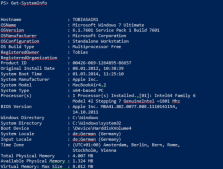封闭在双引号中的字符串能够直接使用变量,这是常用的手法,如代码:
|
1
2
|
$name = $host.Name "Your host is called $name." |
可是这个技巧也有限制。如果你想要显示对象的属性而不是这个变量的本身,例如这样将会失败:
|
1
2
|
PS> "Your host is called $host.Name."Your host is called System.Management.Automation.Internal.Host.InternalHost.Name. |
这是因为PS仅能解决变量的本身(如$host),而不支持它的属性。
同时你也不能控制数字的格式,执行下面代码,结果看起来有很多位数字:
|
1
2
3
4
5
6
7
8
|
# get available space in bytes for C: drive $freeSpace = ([WMI]'Win32_LogicalDisk.DeviceID="C:"').FreeSpace # convert to MB $freeSpaceMB = $freeSpace / 1MB # output "Your C: drive has $freeSpaceMB MB space available." |
这里有一个 -F 方法能同时解决这些问题。只需要将它放在模版文本的左边,它的值就会被正确的带入:
|
1
2
3
4
5
6
7
8
9
|
# insert any data into the text template 'Your host is called {0}.' -f $host.Name # calculate free space on C: in MB $freeSpace = ([WMI]'Win32_LogicalDisk.DeviceID="C:"').FreeSpace $freeSpaceMB = $freeSpace /1MB # output with just ONE digit after the comma 'Your C: drive has {0:n1} MB space available.' -f $freeSpaceMB |
现在你看,使用-F让你有两个有利条件:这里带括号的占位符指出了带入参数的起始位置,同时它还接受格式。“n1”代表保留1位小数。可以改变它来满足你的需求。
支持PS所有版本







